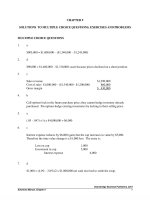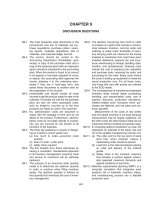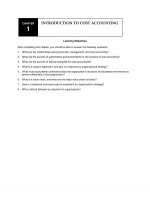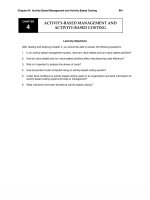Solution manual financial accounting 8th by harrison CH09
Bạn đang xem bản rút gọn của tài liệu. Xem và tải ngay bản đầy đủ của tài liệu tại đây (1.81 MB, 99 trang )
To download more slides, ebook, solutions and test bank, visit
Chapter 9
Stockholders’ Equity
Short Exercises
(5 min.)
S 9-1
Corporation’s advantages:
Continuous life
Transferability of ownership (listed as two items on page
536)
Limited liability of the stockholders
Ease of raising capital (page 536)
Corporation’s disadvantages:
Corporate taxation
Government regulation
Separation of ownership and management (per text page
536)
716
Financial Accounting 8/e Solutions Manual
To download more slides, ebook, solutions and test bank, visit
(5 min.)
S 9-2
1. The stockholders hold ultimate power in a corporation.
2. The chairperson of the board of directors is usually the most
powerful person in a corporation. Title is CEO.
3. The president is in charge of day-to-day operations. Title is
COO.
4. The chief financial officer is in charge of accounting and
finance. Title is CFO.
Chapter 9
Stockholders’ Equity
717
To download more slides, ebook, solutions and test bank, visit
(5-10 min.)
S 9-3
1. The common stockholders are the real owners of a
corporation
2. Preferred stockholders have priority over common
stockholders in (1) receipt of dividends and (2) receipt of
assets if the corporation liquidates.
3. Common stockholders benefit more from a successful
corporation because the preferred stockholders’ dividends
are limited to a specified amount. The common stockholders
take more risk so their potential for gains through an
increase in the company’s stock price is unlimited.
718
Financial Accounting 8/e Solutions Manual
To download more slides, ebook, solutions and test bank, visit
(5-10 min.)
DATE:
_____________
TO:
Karen Scanlon and Jennifer Shaw
FROM:
Student Name
RE:
Steps in forming a corporation
S 9-4
The first step in organizing a corporation is to obtain a charter
from the state. The charter authorizes the corporation to issue
a certain number of shares of stock to the owners of the
business, who are called stockholders. The corporation will
exist when the incorporators
(Per page 536) Pay fees,
Sign the charter,
File documents with the state, and
Agree to a set of bylaws to determine how the corporation
is to be governed internally.
Later steps include the stockholders will electing a board
of directors who in turn appoint officers to manage the
corporation on a day-to-day basis. These officers consist
of the chairperson of the board (the chief executive
officer) and the president (the chief operating officer) who
lead the chief financial officer who manage the day to day
operations of the controller (accounting officer) and
treasurer (finance officer).
Chapter 9
Stockholders’ Equity
719
To download more slides, ebook, solutions and test bank, visit
(5-10 min.)
S 9-5
The $72,927,000 was paid-in capital. It was not a profit and
therefore had no effect on net income.
The par value of stock has no effect on total paid-in capital.
Total paid-in capital is the total amount that stockholders have
invested in (paid into) a corporation, including the par value of
stock issued plus any additional paid-in capital.
(10 min.)
S 9-6
Millions
Horris Printer:
Cash…………………………………………….
Common Stock…………………………….
Additional Paid-in Capital………………..
Delectable Doughnuts:
Cash…………………………………………….
Common Stock…………………………….
720
Financial Accounting 8/e Solutions Manual
17,123
23
17,100
292
292
To download more slides, ebook, solutions and test bank, visit
(10 min.)
S 9-7
Case A — Issue stock and buy the assets in separate
transactions:
Journal
DATE
ACCOUNT TITLES AND EXPLANATION
DEBIT
CREDIT
Cash……………………………………….. 800,000
Common Stock (12,000 × $20)……...
240,000
Paid-in Capital in Excess of Par……
560,000
Issued stock.
Building…………………………………… 550,000
Equipment………………………………… 250,000
Cash……………………………………..
800,000
Purchased plant assets.
Case B — Issue stock to acquire the assets:
Journal
DATE
ACCOUNT TITLES AND EXPLANATION
DEBIT
CREDIT
Building…………………………………… 550,000
Equipment………………………………... 250,000
Common Stock (12,000 × $20)…
240,000
Paid-in Capital in Excess of Par…...
560,000
Issued stock to acquire building and equipment.
The balances in all accounts are the same:
Building……………………………………
Equipment……………………………….…
Common Stock (12,000 x $20
Paid-in Capital in Excess of Par………
Chapter 9
$550,000
250,000
240,000
560,000
Stockholders’ Equity
721
To download more slides, ebook, solutions and test bank, visit
(5-10 min.)
S 9-8
Thousands
Stockholders’ equity:
Common stock, $.01 par, 400 thousand shares
issued……………………………………………...
Paid-in capital in excess of par…………………..
Retained earnings…………………………………..
Other stockholders’ equity………………………..
Total stockholders’ equity………………………...
$ 4
196
647
(22)
$825
(10 min.)
S 9-9
Amounts In Thousands
a. Total revenues………………………………………..
$1,340
Total expenses………………………………………..
806
Net income………………………………….…………
$ 534
b. Accounts payable……………………………………
Other current liabilities……………………………...
Long-term debt………………………………….
Total liabilities………………………………………...
$ 440
2,569
27
$3,036
c. Total liabilities (from Req. b)……………………….
Total stockholders’ equity (from S 9-7)…………..
Total assets……………………………………………
$3,036
825
$3,861
722
Financial Accounting 8/e Solutions Manual
To download more slides, ebook, solutions and test bank, visit
(5 min.)
S 9-10
Journal
DATE
ACCOUNT TITLES AND EXPLANATION
DEBIT
Treasury Stock……………………………...
Cash………………………………………..
Cash…………………………………………..
Treasury Stock…………………………..
Paid-in Capital from Treasury Stock
Transactions…………………………..
CREDIT
Millions
29
29
8
2
6
Overall, stockholders’ equity decreased by $21 million ($29
million paid out minus $8 million received).
Chapter 9
Stockholders’ Equity
723
To download more slides, ebook, solutions and test bank, visit
(15-20 min.)
S 9-11
Req. 1
MEMORANDUM
TO:
Susan Smith Exports, Inc., Board of Directors
FROM:
Student Name
RE:
How the purchase of treasury stock will make it more
difficult for outsiders to take over the company
Purchasing treasury stock decreases the amount of stock
outstanding. If Susan Smith Exports holds a sufficient quantity
of company stock in the treasury, outsiders, such as the Mobile
investor group, may not be able to acquire a controlling interest
(50+ percent) of the outstanding stock from the remaining
stockholders. Because it takes cash to buy treasury stock, the
purchase decreases the size of the corporation. Reducing the
company’s cash position may make the company sufficiently
unattractive to cause the outside investors to abandon their
takeover plan.
Req. 2
Sales of treasury stock at prices above the purchase price
increase company assets because of the greater amount of
assets coming in from the sale than went out to buy the stock.
Treasury stock transactions do not affect liabilities, so the sale
of treasury stock also increases stockholders’ equity. These
sales of treasury stock will not affect net income because the
company is dealing with its owners. Transactions between the
corporation and its owners cannot generate a profit or a loss
that is reported on the income statement.
Student responses may vary.
724
Financial Accounting 8/e Solutions Manual
To download more slides, ebook, solutions and test bank, visit
(10 min.)
S 9-12
Journal
DATE
ACCOUNT TITLES AND EXPLANATION
DEBIT
2010
Dec. 15 Retained Earnings
($110,000 × .06) + (45,000 × $1.00)… 51,600
Dividends Payable…………………
Declared a cash dividend……………
2011
Jan. 4 Dividends Payable…………………… 51,600
Cash………………………………….
Paid the cash dividend.
CREDIT
51,600
51,600
During 2010, Retained Earnings increased by $43,400 (net
income of $95,000 − dividends of $51,600).
(5-10 min.)
S 9-13
1. $360,000 (200,000 shares × $1.80 per share)
2. Preferred: $360,000
Common: $ 40,000
3. Cumulative, because it is not labeled noncumulative
4. Preferred: $1,080,000 ($360,000 × 3)
Common: $ 420,000 ($1,500,000 − $1,080,000)
Chapter 9
Stockholders’ Equity
725
To download more slides, ebook, solutions and test bank, visit
(5-10 min.)
S 9-14
Req. 1
Journal
DATE
ACCOUNT TITLES AND EXPLANATION
DEBIT
CREDIT
May 11 Retained Earnings (13,000 × .15 × $25.00)…… 48,750
Common Stock (13,000 × .15 × $3)………...
5,850
Paid-in Capital in Excess of Par-Common..
42,900
Req. 2
No effect on total assets.
No effect on total liabilities.
No effect on total stockholders’ equity.
726
Financial Accounting 8/e Solutions Manual
To download more slides, ebook, solutions and test bank, visit
(10 min.)
Total stockholders’
equity……………………………..
Less: Preferred
stock………………………………….
Preferred dividends in arrears
(33,000 × .04 × $5 x
3)………………………
Common
equity………………………………………….
Number of common shares outstanding
(63,000 −
1,400)………………………………………..
Book value per share of common
stock…………….
S 9-15
$4,146,000
(195,000)
(19,800)
$3,931,200
÷ 61,600
$
Chapter 9
63.82
Stockholders’ Equity
727
To download more slides, ebook, solutions and test bank, visit
(5-10 min.)
S 9-16
(a)
Rate of return
on total
=
assets
(b)
Rate of return
on common
Net income − Preferred dividends
=
stockholders'
Average common stockholders’ equity
equity
Net income + Interest expense
Average total assets
1. Creditors have loaned money to the company and earn
interest. Stockholders have invested in the corporation’s
stock and thus own the company’s net income. The sum of
interest expense plus net income is the return to the two
groups that have financed the company’s assets.
2. Preferred stockholders have the first claim to the company’s
net income through preferred dividends. Therefore, preferred
dividends are subtracted from net income to compute ROE.
728
Financial Accounting 8/e Solutions Manual
To download more slides, ebook, solutions and test bank, visit
(10-15 min.)
Rate of return
on total
assets
Net
Interest
income + expense
=
Average total assets
S 9-17
=
¥120 + ¥31
(¥10,624 + ¥9,515) / 2
=
¥151
¥10,070
=
1.5%
Note: 10% is considered good in most industries. Therefore,
Godhi’s 1.5% return on assets is very weak.
Rate of return
on common
stockholders’
equity
=
Net
Preferred
income − dividends
Average common
stockholders’ equity
=
¥120 − ¥0
(¥3,212 + ¥2,878) / 2
=
¥120
¥3,045
=
3.9%
Note: 15% is considered good in most industries, so Godhi’s
return on equity is very weak.
Chapter 9
Stockholders’ Equity
729
To download more slides, ebook, solutions and test bank, visit
(20-30 min.)
S 9-18
1. Corporations report common stock and retained earnings
separately to comply with state laws. The laws require
corporations to report stockholders’ equity by source to
distinguish paid-in capital, which cannot be used for cash
dividends, from retained earnings.
2. We should first determine the market value of the land. Then
divide the land’s value by the market value of each share of
stock. The result will tell us how many shares of our stock to
issue for the land.
3. Investors buy common stock in the hope of earning higher
returns on their investment than are available on an
investment in preferred stock.
4. The redemption value of our preferred stock requires us to
pay the preferred stockholders this amount when we buy
back the preferred stock.
5. Book value
per share of
common stock
=
Total stockholders’ equity − Preferred equity
Number of shares of common stock outstanding
The stockholder can multiply book value per share by the
number of shares she owns. The result will be the book value
of her stock.
730
Financial Accounting 8/e Solutions Manual
To download more slides, ebook, solutions and test bank, visit
(5-10 min.)
S 9-19
Billions
Cash flows from financing activities:
Paid off long-term notes payable…………………….
Issued common stock………………………………….
Purchased treasury stock……………………………..
Paid cash dividends……………………………………
Cash flows from financing activities
Chapter 9
$(2.4)
1.1
(3.5)
(1.6)
$(6.4)
Stockholders’ Equity
731
To download more slides, ebook, solutions and test bank, visit
Exercises
Group A
(5-10 min.)
E 9-20A
Req. 1
Journal
DATE
ACCOUNT TITLES AND EXPLANATION
DEBIT
Jan. 19 Cash (12,000 × $6.00)…………………
Common Stock (12,000 × $2.00) ..
Paid-in Capital in Excess of
Par - Common .............................
72,000
Apr.
3 Cash ....................................................
Preferred Stock .............................
54,000
11 Inventory .............................................
Equipment ...........................................
Common Stock (3,700 × $2.00) ....
Paid-in Capital in Excess of
Par - Common .............................
16,000
9,500
CREDIT
24,000
48,000
54,000
7,400
18,100
Req. 2
Stockholders’ equity:
Preferred stock, $1.00, no par
10,000 shares authorized, 400 shares
issued………
Common stock, $2.00 par,
19,000 shares authorized, 15,700 shares issued…
Paid-in capital in excess of par-common
($48,000 +
$18,100)……………………………………….
Retained earnings (deficit)………………………….……
732
Financial Accounting 8/e Solutions Manual
$54,000
31,400
66,100
(43,000)
To download more slides, ebook, solutions and test bank, visit
Total stockholders’ equity……………………….……
Chapter 9
$108,500
Stockholders’ Equity
733
To download more slides, ebook, solutions and test bank, visit
(10-15 min.)
E 9-21A
Stockholders’ Equity
Preferred stock, $4.50 no-par, 10,000 shares
authorized, 600 shares issued ................................. $ 22,000
Common stock, $1.50 par, 19,000 shares
authorized, 5,000 shares issued
7,500
Paid-in capital in excess of par - common .................. 80,550*
Retained earnings .......................................................... 45,000
Total stockholders’ equity........................................ $155,050
_____
*Computation:
April 23: 1,700 shares × ($16.50 − $1.50) =……………………
$25,500
May 12: $19,000 + $41,000 − (3,300 shares × $1.50) =………. 55,050
$80,550
Journal entries (not required):
Apr. 23 Cash……………………………………...
Common Stock ..............................
Paid-in Capital in Excess of Par…
28,050
May
2 Cash ....................................................
Preferred Stock .............................
22,000
12 Inventory .............................................
Equipment ...........................................
Common Stock ..............................
Paid-in Capital in Excess of Par…
19,000
41,000
734
Financial Accounting 8/e Solutions Manual
2,550
25,500
22,000
4,950
55,050
To download more slides, ebook, solutions and test bank, visit
(10 min.)
Paid-in capital consists of:
Preferred equity:
Issued for cash (2,000 shares × $120) ...........
Common equity:
Issued for cash (22,000 shares × $1.00)……
Issued for organizing the corporation
Issued for patent………………………………..
Total paid-in capital……………………………………
E 9-22A
$240,000
22,000
23,000
82,000
$367,000
Unused data:
Net income
Dividends declared
Short-cut solution (also okay):
1. $ 23,000
2.
82,000
3.
240,000 (2,000 × $120)
4.
22,000 (22,000 × $1.00)
$367,000 = Total paid-in capital
Chapter 9
Stockholders’ Equity
735
To download more slides, ebook, solutions and test bank, visit
(10-15 min.)
E 9-23A
Stockholders’ Equity (Thousands)
Common stock, $0.75 par, 800 shares
authorized, 320 shares issued……………………… $
240
Paid-in capital in excess of par…………………………
899
Retained earnings…………………………………………
2,220
Other stockholders’ equity………………………………
(730)
Less: Treasury stock, common, 100 shares at cost..
(1,150)
Total stockholders’ equity…………………………...
$1,479
Patterson Software paid a higher price to acquire treasury
stock than the price Patterson received when it issued its
stock. This explains why Treasury Stock has a greater balance
than the sum of Common Stock plus Paid-in Capital in Excess
of Par.
736
Financial Accounting 8/e Solutions Manual
To download more slides, ebook, solutions and test bank, visit
(10-15 min.)
E 9-24A
Journal
DATE
ACCOUNT TITLES AND EXPLANATION
DEBIT
CREDIT
Jan. 17 Cash (2,200 × $10)…………………….
22,000
Common Stock (2,200 × $2.50)………
5,500
Paid-in Capital in Excess of Par…….
16,500
To issue common stock.
May 23 Treasury Stock - Common (300 × $12)...
Cash……………………………………...
To purchase treasury stock.
3,600
3,600
Jul. 11 Cash (200 × $20)…………………………... 4,000
Treasury Stock - Common (200 × $12)
2,400
Paid-in Capital from Treasury
Stock Transactions………………..
1,600
To sell treasury stock.
Overall effect on stockholders’ equity
($22,000 − $3,600 + $4,000)………………………………
increase
Chapter 9
$22,400
Stockholders’ Equity
737
To download more slides, ebook, solutions and test bank, visit
(10 min.)
E 9-25A
Journal
DATE
ACCOUNT TITLES AND EXPLANATION
DEBIT
Millions
108
16
92
b.
Cash (8 million × $13.50)…………………….
Common Stock (8 million × $2.00)……...
Capital in Excess of Par Value………….
c.
Treasury Stock………………………………..
Cash………………………………………….
16
Retained Earnings……………………………
Dividends Payable…………………………
31
Dividends Payable……………………………
Cash……………………………………….…
31
or one entry only:
Retained Earnings …………………………...
Cash……………………………………….…
31
d.
738
Financial Accounting 8/e Solutions Manual
CREDIT
16
31
31
31
To download more slides, ebook, solutions and test bank, visit
(10 min.)
E 9-26A
Dollars in
Millions
Stockholders’ Equity:
Common stock, $2.00 par value,
10.1 million shares issued ($4.2 + $16.0)
Capital in excess of par value ($8,400 + $92,000)
Retained earnings ($250 + $446 − $31)…………
Treasury stock, 2 million shares at cost………….
Total stockholders’ equity…………………………
Chapter 9
$ 20,200
100,400
665
(16,070)
$105,195
Stockholders’ Equity
739
To download more slides, ebook, solutions and test bank, visit
(20-30 min.)
E 9-27A
Req. 1
Conversion of preferred stock into common stock
Retirement of preferred stock
Req. 2
Issuance of common stock:
a. To preferred stockholders who converted their preferred
into common
b. For cash or other assets
c. Stock dividend
Req. 3
(Millions
of shares
of stock)
Dec. 31, 2011
Common shares issued…………………………….
300
Less: Treasury stock, number of shares………
(52)
Common shares outstanding……………………...
288
740
Financial Accounting 8/e Solutions Manual









